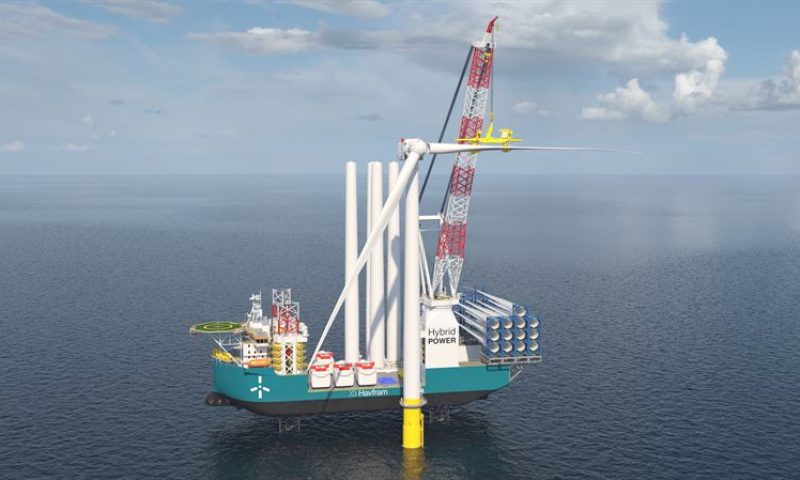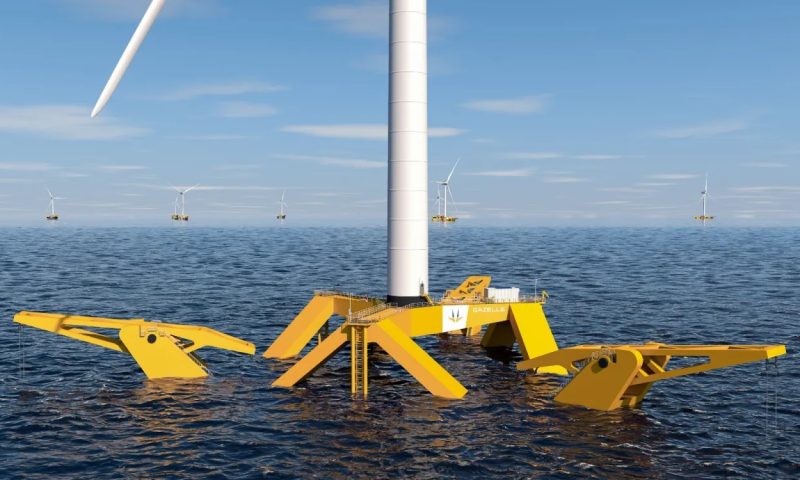
Gulliver Installs 1400t Substation at RWE’s Kaskasi OWF
Installing 1400t Substation
Kaskasi is RWE’s sixth wind farm off the German coast, the 342 megawatt project is being built 35 kilometers north of the island of Heligoland and recently celebrated a ‘wedding ‘on the high seas.
Wedding
A ‘wedding’ is what the construction process is called when the substation topside is successfully placed on the foundation.
Substation
The offshore substation is the heart, where electricity generated by each wind turbine flows together to be converted to the necessary transmission voltage.

SCALDIS’ Heavy Lift Vessel Gulliver
1,400t Substation
The journey of the 1,400t substation topside started in Danish Aalborg at the manufacturing facility of Bladt Industries and took two days to ship across the North Sea.
Heavy Lift Vessel
Gulliver, a Floating Heavy Lift Vessel of SCALDIS, placed the substation onto the monopile foundation, completing the installation of the heaviest component of the Kaskasi offshore wind farm.

Seaway, DEME, Fred & Olsen
Strashnov, Neptune, Sea Challenger and Blue Tern
In parallel, foundation installation works are underway: With Seaway 7’s Strashnov, DEME’s Neptune and Sea Challenger and Fred Olsen’s Blue Tern, four vessels are engaged in the installation of a total of 38 monopile foundations for the wind turbines and their transition pieces.
Operation Details
The foundations, each up to 64m long, weigh up to 740t – approximately equivalent to 600 small cars. The operations and processes at the offshore construction site are coordinated around the clock by the RWE Control Room on Heligoland.
The nautical staff at Ems Maritime Offshore are supporting the RWE team.

Installing 1400t Substation; Installing The Foundations
To install the foundations into the seabed at depths of 18m to 25m, RWE is utilizing two installation methods:
conventional hammering and innovative vibro pile driving technology, which has the potential to reduce underwater noise emissions. This benefits the marine environment in particular.
Vibro Technology
The pilot implementation of the vibro technology at Kaskasi is accompanied by the “VISSKA” research project, which is funded by the German Federal Ministry of Economic Affairs and Climate Action.

About RWE
RWE is leading technological development in the offshore wind industry. At the Kaskasi offshore wind farm, three new technologies will be tested.
The Plan
RWE plan to install special collars around three monopile foundations (Collared Monopile). A further innovation is the introduction of foundations which were installed using vibro pile driving and are enclosed in a concrete ring that expands in the seabed (Self-Expanding Pile Shoe).
Product
In addition, a sustainable product will be celebrating its German premiere at Kaskasi: Siemens Gamesa and RWE will equip a number of wind turbines with recyclable rotor blades.
Recyclable Rotor Blades
The blades are the first of their kind, thanks to an innovative resin that enables components to be recycled for new applications at the end of their lifecycle.
Turbine Installation
Installation of the wind turbines is scheduled to start this summer. By the end of 2022, a total of 38 wind turbines are to be fully operational.
Then, the Kaskasi offshore wind farm will have the capacity to supply the equivalent of approximately 400,000 households with green electricity every year.

RWE in The Field of Renewable Energy
RWE is one of the leading companies in the field of renewable energies and No.2 worldwide in offshore wind.

As part of its ambitious investment and growth strategy, “Growing Green”, the company plans to triple its global offshore wind capacity by 2030, thus increasing from the current 2.4 gigawatts (GW) to 8 GW.
RWE In Germany
Also in Germany, RWE is stepping up the pace: by 2030, the company intends to invest up to 15 billion euros in the green energy sector.
Expanding the offshore wind energy market
RWE continues to expand in the offshore wind energy market too: together with its Canadian partner, Northland Power, RWE is driving forward the development of a large offshore wind cluster in the German North Sea.
RWE’s Partners
The partners plan to construct a cluster of three wind farms north of the German island of Juist with a total installed capacity of over 1.3 GW, which are expected to commence operation in 2026 and 2028 respectively.
New Offshore Windfarms
These planned offshore wind farms will be able to produce enough green electricity to meet the requirements of up to 1.6 million households per year. RWE is also developing a further wind farm in the direct vicinity with a capacity of 225 megawatts.











